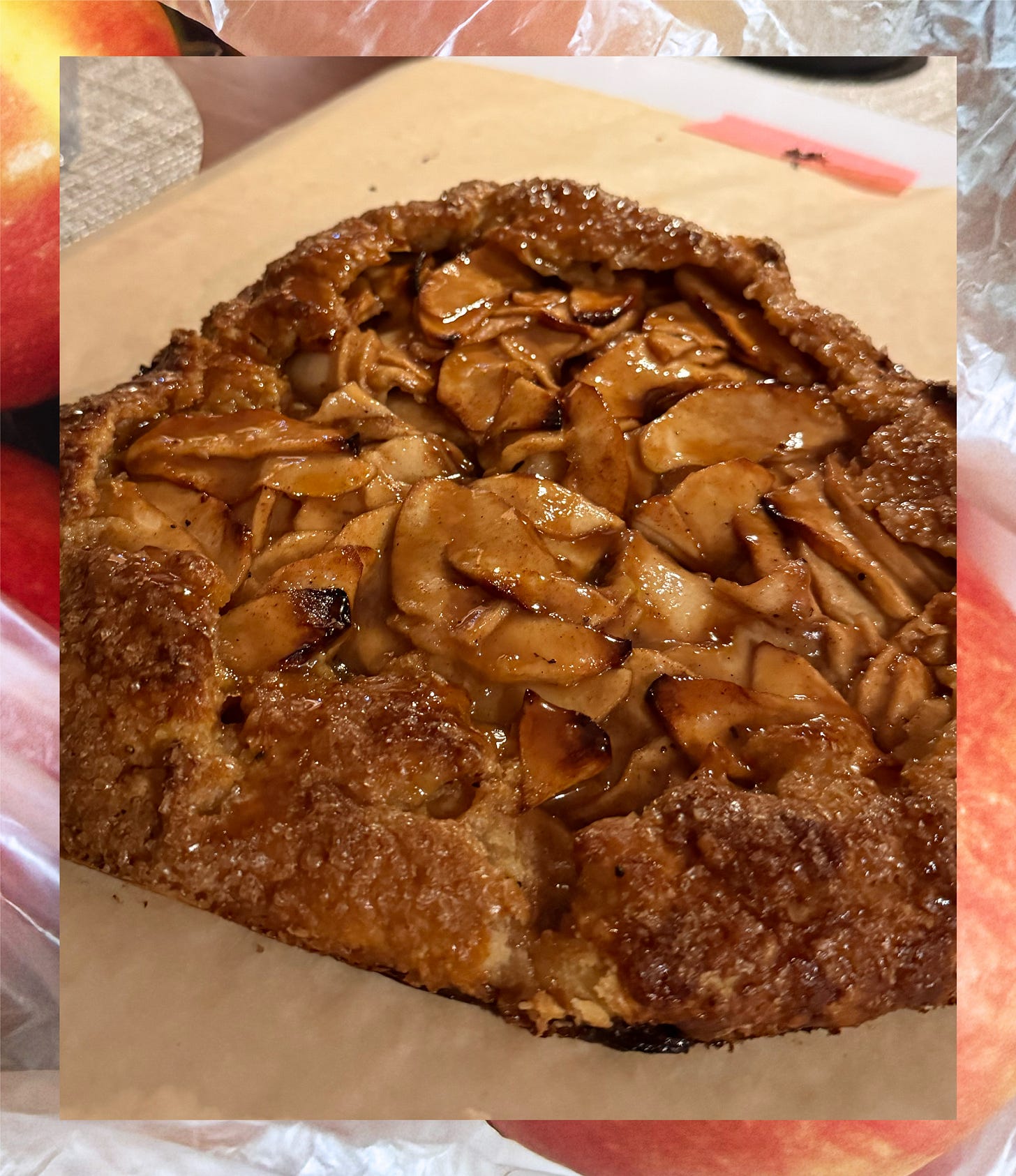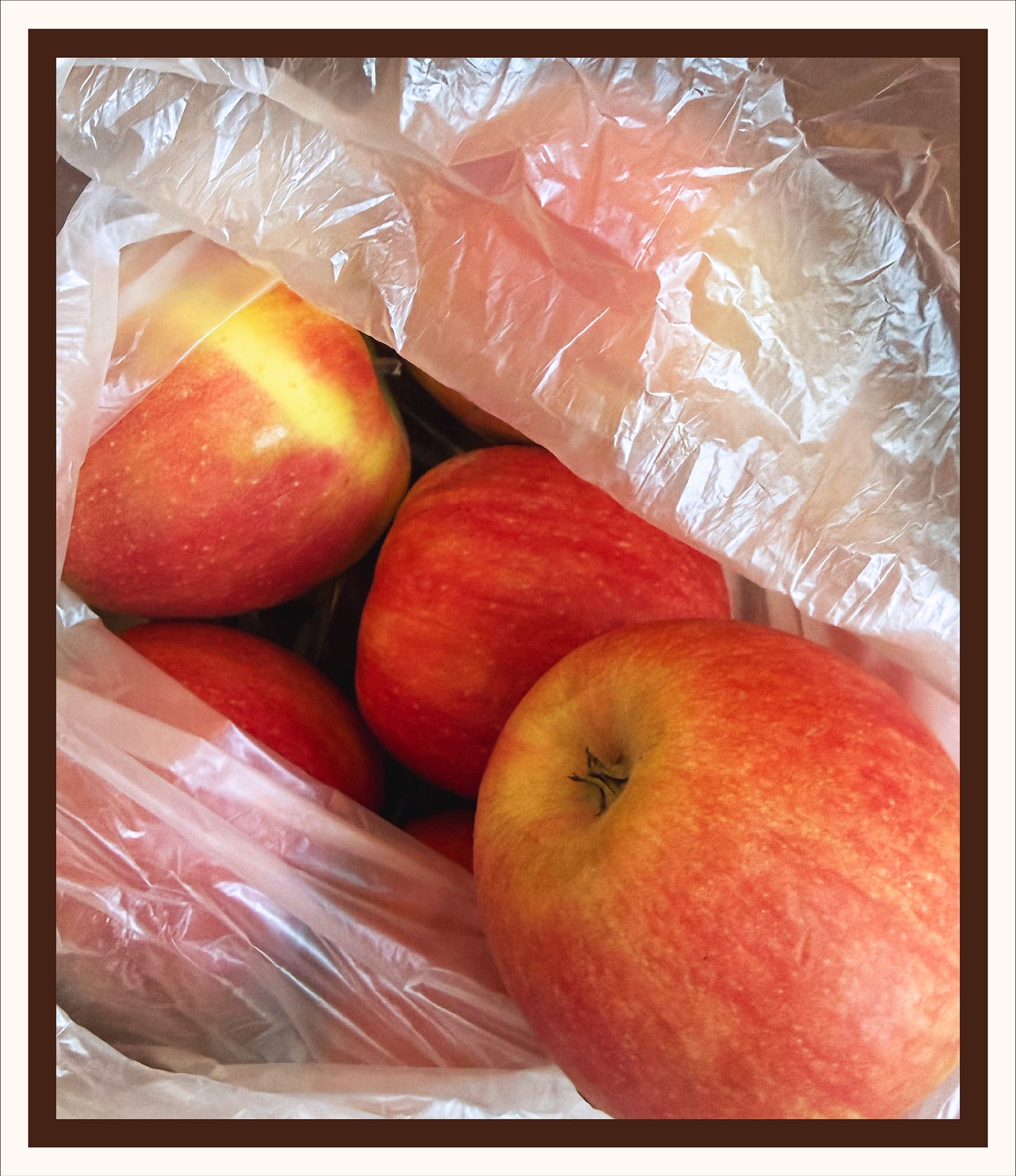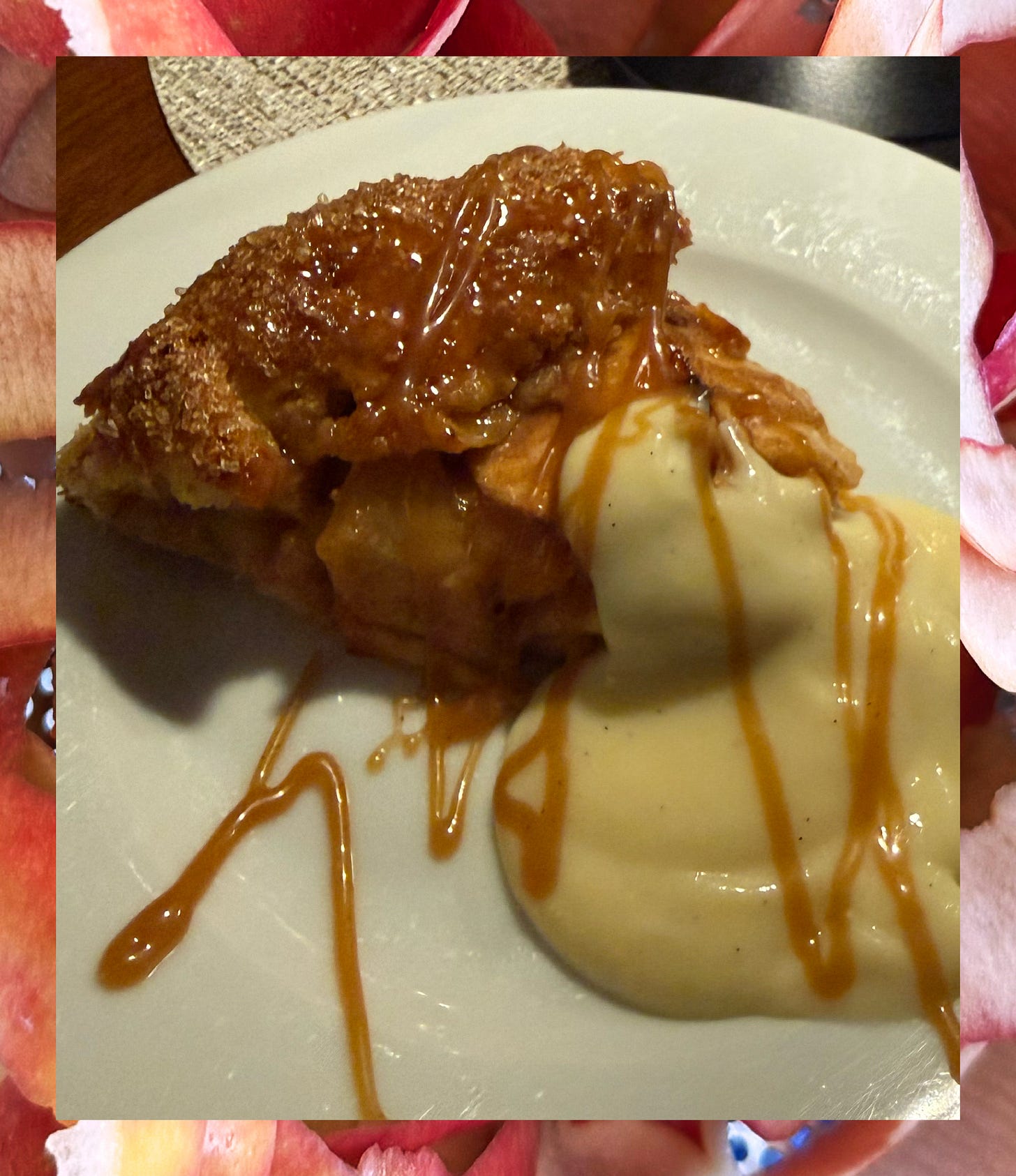Caramel Apple Galette
Casual, utilitarian, and luxurious. Galettes are better than pie.
I’m sorry to all of my friends who are die-hard summer fans, but you had your fun. Summer is over and it’s finally getting chilly in New York. All of the lovely “fall things” are so much more enjoyable when you have weather to match. Sadly, I made this caramel-apple galette last weekend when it was still 80°F outside, so I didn’t personally get the full effect. But I like to think its creation helped manifest the now 60°F days we’re getting.
If you read my earlier post, ‘A Meditation on the Farmers Market’, you’ll remember we learned “people don’t like concord grapes”—unfortunate because I was going to make Claire Saffitz’s Apple & Concord Grape Crumble Pie for a dinner party and went to the market specifically looking for nice, in-season concord grapes! But, what do we do when things don’t go according to plan? We feel sad, get over it, and come up with a new, perhaps better plan.
The better plan.
If concord grape and apple was a uniquely tart spin on traditional apple pie, then caramel-apple, I decided, would be a tried and true pivot towards autumnal sweetness. And, instead of making pie (my achilles heel/arch nemesis) I decided to make a galette instead—which, in my opinion, is far superior to pie. The ratio of crust to filling in a galette feels more appropriate and akin to a deceptively simple pastry. There’s no need to worry about the crust sliding down a pan during a par bake (and, hello, you don’t even need to par bake galettes!), which leads to the final and most pleasurable point—they don’t need a special pan to bake in. A galette is self-contained, celebrating the best part of pie—the crust—which is both the feature and the function. It belongs in the Venn diagram of things that are casual, utilitarian, and luxurious. (What else would be on this diagram? A slice of F&F pepperoni pizza, fresh bread with butter and salt, apples & peanut butter, a perfectly broken-in pair of jeans, etc.).
And lastly, pie without ice cream (or, in this case, custard) is nonsensical. I love when the scoop of ice cream melts and becomes a creamy, swirling pool, drowning my slice of pie. This time, instead of making or buying ice cream, I wanted to go straight to that “melted ice cream” state by including a vanilla custard.
A recurring theme of mine is to feel a little ashamed of going to the trouble (it’s actually not trouble, I enjoy doing this!) of writing a recipe just to route you to someone else’s recipe. Excuse me while I go down the rabbit hole of, Am I even good at cooking and baking? Am I a hack? Will I ever fill all these knowledge gaps? Am I stealing? A soothing and reasonable conclusion I return to is that cooking, like art, is a recycling of things we’ve learned from each other and pulled from the mysterious place that is our collective unconscious. Besides, we can’t always do everything on our own and I feel very lucky to learn from and recommend so many talented chefs out there. With that said, the idea for this recipe was executed by frankensteining (spooky!) recipes I found online and in Claire Safftiz’s book ‘Dessert Person’.
PIE CRUST
As mentioned, I used Claire Safftiz’s recipe. Something I learned from her technique was the method of integrating butter 2 ways into flour; 1) work the butter with your fingers to get to a sandy consistency, and 2) add chunks of butter which you press into larger, thin “sheets”. These two consistencies really do create a tender, flaky, layered crust, almost like a puff pastry.
APPLE FILLING
Even though I was going to change the flavor and format, I still referred to Claire’s recipe and method for the Apple and Concord Grape Crumble Pie as a guide for the filling. It worked fine!
4 pink lady apples
Lemon juice from 1 lemon
2 tbsp brown sugar
2 tsp kosher salt
Vanilla paste (you can also use extract) poured from the heart (for me that means ~2 tsp)
2 tsp cinnamon
.5 - 1 tsp cardamom (it can be overpowering if you use too much, so start small and build to a level you’re comfortable with)
1 tbsp potato starch
CARAMEL
Caramel is delicious but scary. Maybe danger is part of the appeal. But, for anyone who wants to try making caramel, please be cautious, overly cautious even. It’s much hotter than you think and, because melted sugar is essentially glue, it will stick to whatever it touches. My husband got overly excited to try it when it was still in this lava hot phase and swiped the tip of his finger against a caramel-coated spoon. He was running his scorched finger under cold water for at least 20 minutes and I was overbearingly nervous about the state of his finger for the rest of the day (he’s fine now and the blister has disappeared).
As a non-experienced caramel maker, I failed an attempt with one recipe and decided to find one with the word “easy” in the title. If I hadn’t failed the earlier attempt, and Shane hadn’t burned his finger, this recipe would have fooled me into thinking caramel is actually super easy, what’s all the fuss about? I didn’t use a candy thermometer which was very pleasing because I generally find some gadgets distracting and cumbersome, especially when you can use your eyeballs to determine when the caramel is ready to take off the heat (it will turn a honey golden brown).
VANILLA CUSTARD
I wanted the consistency of a looser “sauce” rather than a thicker cream “filling”. I didn’t know it at the time but I was looking for creme anglaise, part of the cooked custard family. I found the ‘Pastry School 101’ Substack by Anna Ramiz who did a deep dive on custard and creme anglaise. I would love to try her creme anglaise recipe, but found that this one worked quite well. Ah, it’s moments like these when I love the Internet!
TIMING
As far as timing is concerned, I made and chilled the dough the night before and made the caramel that morning. After the caramel I made the apple filling, and while the galette was baking I made the creme anglaise.
Method
I’m only going to cover the method for the apple filling because the other recipes I’ve linked to have it covered and I didn’t deviate from either.
Prep apples. Peel, core, and cut your apples into thin slices. (I chose thinness based on the aesthetic, desired mouthfeel, and cooking time, but you could go chunkier if you wanted to try it).
Make apple mixture. In a large enough bowl to fit the apple slices, mix together the sugars, cinnamon, cardamom, and vanilla. Let this sit for about 30-40 minutes while the juices settle at the bottom. (While this sits, it would also be a good time to make the creme anglaise).
Separate liquid from apple slices. Once liquid has accumulated at the bottom of the bowl (you’ll have to scoot the apple slices out of the way to take a peek), gently squeeze the apple slices and transfer to another similarly-sized bowl (try not to break any of the apple slices during this process. Inevitably some will, but I liked trying to get as much excess liquid out as possible).
Reduce liquid. Pour the liquid into a sauce pan on medium high heat and bring to a simmer. Stir occasionally until it becomes syrupy (10-15 minutes). Remove from the heat.
Preheat your oven to 350°F and prepare a pan for the crust.
Make a potato starch slurry. Put the potato starch in a small bowl with a few spoonfuls of the apple liquid and stir until smooth. Add this slurry to the saucepan that has the apple liquid still in it and simmer until it thickens (don’t let this become too thick, just enough to lightly coat the back of a spoon). Set aside.
Roll out the dough. Take your pie dough out of the fridge and roll it out into a large circle shape (or as close to circular as you can get it). I always end up with a dough that cracks around the edges as I’m rolling it out. But with a galette, that’s not really a problem (have I sold you yet?). If this happens, just press the cracks back together without overworking and keep rolling until it’s large enough for your filling. Transfer the dough, laying it flat on a baking sheet lined with parchment paper.
Combine liquid mixture with apple slices. Take the apple liquid mixture and pour over the bowl of apples. Stir with your hands (if the liquid is cool) or a spatula to gently coat all of the apple slices with the syrupy mixture. Scoop the mixture onto the dough. I left about a 3-5 inch margin around the perimeter of the dough so that I had enough to encase the filling. Don’t pile the apple mixture too high or else the dough won’t cook through, and you may get a soggy bottom.
Fold the dough on top of the apple mixture.
Egg wash. Beat 1 egg and brush on the folded dough and sprinkle demerara sugar all over the dough.
Bake. Bake the galette until the crust is deeply golden brown (~1 hour 1 hour, 15 minutes).
Cool and serve. Remove from the oven and drizzle however much caramel you want on top while it’s still hot. I did about .25 of the caramel and saved the rest for plating. Let the galette cool for as long as you can stand it.
Serve. To plate, spoon some creme anglaise on top of the galette slice and drizzle with more caramel & a sprinkle of flakey salt.







this gallete was the most delicious thing I've had in a long time!! It was probably my favorite "pie-like" dessert ever!!!!